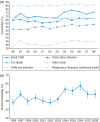Assessing the knowledge of the potential harm to others caused by second-hand smoke and its impact on protective behaviours at home
- PMID: 22201034
- PMCID: PMC3355753
- DOI: 10.1093/pubmed/fdr104
Assessing the knowledge of the potential harm to others caused by second-hand smoke and its impact on protective behaviours at home
Abstract
Background: Smokers' knowledge of the risks of second-hand smoke (SHS) and the role this plays in implementing behaviours to reduce the SHS exposure of others have not been thoroughly explored. Mass media health promotion is used to promote behaviour change partly by providing information on the consequences of behaviour. In England, between 2003 and 2006, frequent mass media campaigns highlighted the toxicity of SHS.
Objectives: To examine peoples' knowledge of SHS-related illnesses in England over time, identify the determinants of good knowledge and to assess its importance in predicting SHS-protective behaviours.
Methods: Statistical analysis of repeat cross-sectional data (1996-2008) from the Omnibus Survey to explore the trends and determinants of knowledge of SHS-related illnesses and the determinants of SHS-protective behaviours.
Results: Only 40% of smokers had 'good' knowledge of SHS-related illnesses compared with 65% of never smokers. Knowledge increased markedly when frequent SHS-related mass media campaigns (2003-06) ran, compared with earlier years (1996-2002). Smokers with better knowledge were more likely to have smoke-free homes [odds ratio (OR): 1.10, 1.04-1.16] and abstain from smoking in a room with children (OR: 1.11, 1.09-1.14).
Conclusions: The low levels of knowledge of some SHS-related conditions, especially among smokers, and the relationship between knowledge and SHS-protective behaviours, suggest that greater efforts to educate smokers about the risks associated with SHS are worthwhile.
Figures
Similar articles
-
Pet owners' attitudes and behaviours related to smoking and second-hand smoke: a pilot study.Tob Control. 2009 Apr;18(2):156-8. doi: 10.1136/tc.2008.028282. Epub 2009 Feb 10. Tob Control. 2009. PMID: 19208667
-
Children's exposure to second-hand smoke in the home: a household survey in the North of England.Health Soc Care Community. 2010 May;18(3):257-63. doi: 10.1111/j.1365-2524.2009.00890.x. Epub 2009 Dec 29. Health Soc Care Community. 2010. PMID: 20050935
-
Muslim Communities Learning About Second-hand Smoke in Bangladesh (MCLASS II): study protocol for a cluster randomised controlled trial of a community-based smoke-free homes intervention, with or without Indoor Air Quality feedback.Trials. 2019 Jan 5;20(1):11. doi: 10.1186/s13063-018-3100-y. Trials. 2019. PMID: 30611292 Free PMC article.
-
A systematic review of second-hand smoking mass media campaigns (2002-2022).BMC Public Health. 2024 Mar 4;24(1):693. doi: 10.1186/s12889-024-18222-5. BMC Public Health. 2024. PMID: 38438990 Free PMC article.
-
Evolution and characteristics of studies estimating attributable mortality to second-hand smoke: a systematic review.Eur J Public Health. 2024 Jun 7;34(3):557-565. doi: 10.1093/eurpub/ckae049. Eur J Public Health. 2024. PMID: 38531674 Free PMC article.
Cited by
-
Need for sensitization on serious threats of second-hand smoke: Findings from a national study in Mauritius, a small island developing state in the Indian Ocean.Prev Med Rep. 2021 Dec 13;25:101667. doi: 10.1016/j.pmedr.2021.101667. eCollection 2022 Feb. Prev Med Rep. 2021. PMID: 35127351 Free PMC article.
-
Parental risk perceptions of child exposure to tobacco smoke.BMC Public Health. 2015 Feb 6;15:90. doi: 10.1186/s12889-015-1434-x. BMC Public Health. 2015. PMID: 25885053 Free PMC article.
-
Tobacco control environment: cross-sectional survey of policy implementation, social unacceptability, knowledge of tobacco health harms and relationship to quit ratio in 17 low-income, middle-income and high-income countries.BMJ Open. 2017 Mar 31;7(3):e013817. doi: 10.1136/bmjopen-2016-013817. BMJ Open. 2017. PMID: 28363924 Free PMC article.
-
Secondhand smoke knowledge, sources of information, and associated factors among hospital staff.PLoS One. 2019 Jan 22;14(1):e0210981. doi: 10.1371/journal.pone.0210981. eCollection 2019. PLoS One. 2019. PMID: 30668578 Free PMC article.
-
Babies Living Safe and Smokefree (BLiSS) Intervention Reduces Children's Tobacco Smoke Exposure Directly and Indirectly by Improving Maternal Smokers' Urge Management Skills and Exposure Protection Behaviors.Int J Environ Res Public Health. 2025 Feb 11;22(2):254. doi: 10.3390/ijerph22020254. Int J Environ Res Public Health. 2025. PMID: 40003480 Free PMC article. Clinical Trial.
References
-
- Klesges RC, Somes G, Pascale RW, et al. Knowledge and beliefs regarding the consequences of cigarette smoking and their relationships to smoking status in a biracial sample. Health Psychol. 1988;7(5):387–401. - PubMed
-
- Farquhar JW, Maccoby N, Solomon DS. Community applications of behavioral medicine. In: Gentry WD, editor. Handbook of Behavioral Medicine. New York: Guilford; 1984. pp. 437–78.
-
- Nourjah P, Wagener DK, Eberhardt M, et al. Knowledge of risk factors and risk behaviours related to coronary heart disease among blue and white collar males. J Public Health Policy. 1994;15:443–59. - PubMed
-
- Janz N, Becker MH. The health belief model: a decade later. Health Educ Q. 1984;11(1):1–47. - PubMed
Publication types
MeSH terms
Substances
Grants and funding
LinkOut - more resources
Full Text Sources
Medical
Miscellaneous


